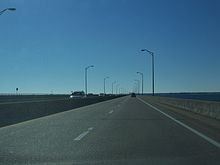Pensacola Bay Bridge
| Pensacola Bay Bridge | |
|---|---|

On the bridge, heading south
|
|
| Coordinates | 30°23′46″N 87°11′08″W / 30.395983°N 87.185644°WCoordinates: 30°23′46″N 87°11′08″W / 30.395983°N 87.185644°W |
| Carries | 4 lanes of |
| Crosses | Pensacola Bay |
| Locale | Pensacola, Florida, and Gulf Breeze, Florida, U.S. |
| Official name | Philip Dane Beall, Sr., Memorial Bridge |
| Maintained by | Florida Department of Transportation (FDOT) |
| ID number | 480035 |
| Characteristics | |
| Design | Reinforced concrete girder bridge |
| Total length | 15,640 feet (4,767.1 meters) |
| Width | 55 feet (16.8 meters) |
| Clearance below | 50 feet (15.2 meters) |
| History | |
| Opened | June 13, 1931 (original bridge) October 31, 1960 (current bridge) |
| Statistics | |
| Daily traffic | 50,065 |
The Pensacola Bay Bridge, also known locally as the Three-Mile Bridge, runs between downtown Pensacola, Florida, and Gulf Breeze, Florida. It carries four lanes of U.S. Highway 98 across Pensacola Bay.
The bridge, which is dedicated to Sen. Phillip D. Beall Sr., opened to traffic on October 31, 1960, at which time it replaced the Thomas A. Johnson Bridge, a narrow two-lane facility that ran parallel just to the east. This original bridge, which had been in service since June 13, 1931, was tolled and was signed as TOLL US 98 until the bridge bonds were paid off. The decommissioned original bridge served as two 1.5-mile-long fishing piers until they were largely destroyed by Hurricane Ivan in 2004. By 2007, the remainder of the northernmost fishing pier was demolished. Demolition has begun on the southernmost part of the fishing pier. In 2010, construction was completed on a northern replacement fishing pier about half as long as the original pier.
In 1989, the bridge was struck by a barge and was out of service for several months. All traffic was diverted to ferries, causing severe backups in both Gulf Breeze and downtown Pensacola. The Florida Department of Transportation took the opportunity to modernize the bridge, adding emergency lanes and replacing barrier walls and lighting.
FDOT announced in January 2010, near the end of the bridge's 50-year design life, that the bridge was structurally deficient and would have to be replaced within six years. As of 2011, a study is underway to determine the "feasibility, location, and conceptual design" of a replacement bridge. As of February 2013, plans have begun to replace the bridge with construction beginning within two years, at a cost of $595.6 million, on a course slightly to the west of the existing bridge. The new bridge, like the current one, will not charge a toll.
...
Wikipedia
